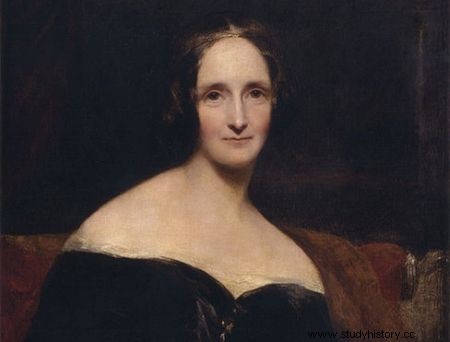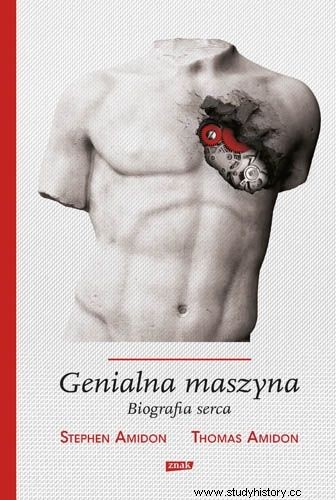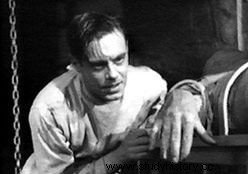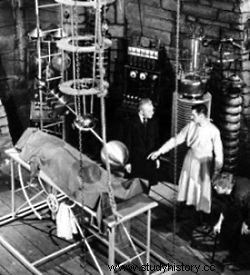At first glance - a monster. A little spooky, a little shocking, in other words, a plastic surgeon's nightmare. This is the "work" of Dr. Frankenstein we know. But where did the author come up with the idea for this dark tale, and what does Lord Byron have to do with it? Well ... it all started with a frog.
When an Italian doctor dissected a frog in 1780, he probably had no idea that he would indirectly contribute to one of the most famous elements of pop culture - the Frankenstein story. Luigi Galvani - because we are talking about him - discovered an interesting phenomenon quite by accident. When he inadvertently touched the frog he was cutting with an electrified scalpel, it moved. The nephew of the Italian medic, Giovanni Aldini, went a step further and continued his research in London. By experimenting with the corpses of convicts, he showed that electricity connected to the dead body it can stimulate the work of his muscles, including the heart, for up to two hours after death. The discovery was called "galvanism" and is still used today (defibrillators). But we are not about that.
Mary, the frog, Byron and killing boredom
While Aldini was conducting his experiments, a lady was born in London. Mary Shelley, because she is what, besides causing a nasty scandal as a teenager (Percy Shelley, with whom she fled to Europe and whom she eventually married, was already married), she became one of the precursors of the SF novel.

Mary Shelley. She created Frankenstein out of boredom and a bit by accident.
In 1816, a colorful company enjoyed the villa Diodati on the shores of Lake Geneva. Among others, Mary and Percy Shelley, John Polidori and the famous poet Lord Byron spent their holidays here. The summerers had fun with conversations and memories. Then Mr. Shelley told a story straight from his university on how a certain lecturer decided to introduce students to the secrets of the above-mentioned experiment with a frog. After analyzing its course, Shelley, Polidori, and Byron entered into a lively discussion about Galvani and Aldini's research, to which Mary Shelley was listening.

On a rainy afternoon, having nothing better to do, the company began - to mutual delight - to invent and tell stories about ghosts (we are talking here about the times when the Gothic novel with all its ghastly reigned supreme). Everyone had to prepare a terrible story for the contest proposed by Lord Byron . It was then that Mrs. Shelley remembered talking about electroplating.
Although the weather improved and the gentlemen abandoned the competition in favor of a mountain trip, Mary did not accompany them. She had had a miscarriage not long before and was still weak, so she stayed home. How can we learn from the book by Stephen and Thomas Amidons Fri "Brilliant machine", it was then - in order to chase away boredom - began to weave on paper a dark story about a scientist overwhelmed by the desire to create life.

It is alive!
And let the lightning strike ... his work
The resulting story was about a young student who felt like Galvani and Aldini. Ba! He felt better than them, which translated into his enormous ambition. He modeled himself on the works of Renaissance anatomists, but what they cut, he - Doctor Wiktor Frankenstein - sewed. And this is how the Monster was created in the attic room. The combined fragments of various corpses and an exceptionally strong heart, which was said to have been the source of strength and endurance for his "work", the doctor miraculously revived. The then readers explained it with the use of electricity (known from the screen adaptation of the lightning discharge necessary to complete the process). Such reasoning in the era of fascination with pathology and discoveries related to the properties of the human body is not particularly surprising.

All because of these frogs…
As a warning
Mary Shelley's reflections on the dilemma of a man who puts himself on an equal footing with God the creator echo the medical revolution of the time. The nineteenth-century author, observing the incredible pace of the development of medicine, asked herself about the moral and ethical boundaries of experiments and made a bit of a mess. She had a story-warning that was screened many times (including the most famous one from 1931) and became a permanent feature of mass culture.
Though Mary Shelley was far ahead of her era in her vision, she did not abandon the romanticism inherent in her. Although Frankenstein's Monstrosity is a medical experiment at the mercy of its creator, it has a heart that is capable of love. After all, the rejected monster feels a verter-like weltschmerz!
Sources:
- Stephen Amidon, Thomas Amidon, A genius machine. Heart biography , Znak Publishing House, Krakow 2012.
